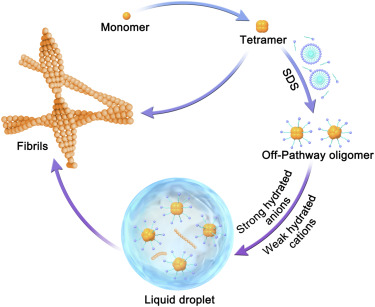Abstract
Soluble amyloid-β oligomers (AβOs) are proposed to instigate and mediate the pathology of Alzheimer’s disease, but the mechanisms involved are not clear. In this study, we reported that AβOs can undergo liquid–liquid phase separation (LLPS) to form liquid-like droplets in vitro. We determined that AβOs exhibited an α-helix conformation in a membrane-mimicking environment of SDS. Importantly, SDS is capable of reconfiguring the assembly of different AβOs to induce their LLPS. Moreover, we found that the droplet formation of AβOs was promoted by strong hydrated anions and weak hydrated cations, suggesting that hydrophobic interactions play a key role in mediating phase separation of AβOs. Finally, we observed that LLPS of AβOs can further promote Aβ to form amyloid fibrils, which can be modulated by (−)-epigallocatechin gallate. Our study highlights amyloid oligomers as an important entity involved in protein liquid-to-solid phase transition and reveals the regulatory role of LLPS underlying amyloid protein aggregation, which may be relevant to the pathological process of Alzheimer’s disease.

